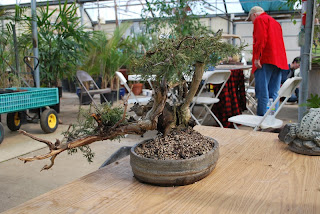I am continuing a series on Progressions, to show the value of keeping good visual records of the trees we style.
Here is a nice twin-trunk Alpine Fir (Abies Lasiocarpa), which was purchased from a friend (thanks Ian Burke!) in 2008. I had seen the tree in 2006 at a HoYoKu session in Shady Side Maryland, where Ian had brought the tree there for additional bonsai work.

The tree had a lot of potential, and needed a complete overhaul in planting angle and styling. Additional years would be required to build out the foliage pads and ramify them to more substantial visual masses.
The first step was to figure out what the style should be. I like to put up sketches of various ideas, then pick the one which makes the most impact.

This idea seemed to make the most of what the tree had to offer, so was adopted as the style. The lowest branch on the right would need to be shortened and jinned, to emphasize the apex.
The Mother-Daughter style also required compacting of the Daughter trunk, so it actually looked like a smaller tree being sheltered by the Mother trunk.
Fine wiring was added to position all branches, and the old roots farthest from both trunks (which had dried out in the original container in which the tree was planted) were worked to remove dead bark and expose the beautiful deadwood beneath.
Next step was to decide on a pot appropriate for the tree.
I wanted to put it into a container which mirrored the harsh conditions in which the tree grew naturally, which is above 300 meters in the US Western mountains.
A slab of some sort would be a good start.
While browsing through many bonsai potter websites, I came to that of Ron Lang, who lives about 1 hour west of Natures Way Nursery, outside of Harrisburg Pa. On his site, Ron had a stack of slabs of various sizes showing under the Styles tab. This image immediately reminded me of upthrust slabs of rock, where a Fir might grow.

I called Ron with this idea, and he was very excited about the possibility, so invited me to his studio to bring up the tree and to put a pot design together.
We worked for some time, and came up with a model. Ron and his wife took measurements of the tree, and worked out the dimensions and flow of the simulated rock outcrop.
Ron put on his creative potters' cap, and came up with a marvelous pot which looks very much like a rocky outcrop.

The Fir was repotted into the slab the following spring, and the combination is quite dramatic.

Here is the tree freshly potted in its' new home.
The additional work to shorten the lower right branch and compact the foliage was carried out.
Some cleanup on the foliage was performed, and deadwood on the leftmost dead root was treated.

In the Fall of 2009, Bill Valavanis was invited to do a workshop at Pennsylvania Bonsai. I brought the Fir so he could see it. He immediately asked to have it in the 2010 US National Bonsai Exhibition!
This was a wonderful experience both for the Fir and for me. The Exhibition was judged by three Bonsai masters: David Easterbrook, Ferrand Block (of Bonsai Focus) , and Kunio Kobiashi (probably one of the top 2 or 3 Japanese masters).

Hovering in the aisle adjacent to the Fir, I overheard many comments. One viewer wondered at how closely the rock slabs had been fitted. This person could not believe that these slabs were in fact a pot!
After the Exhibition, we spent several days in a private session with Kobiashi-san, where he had additional very constructive comments on future work for the Fir.
The Fir has continued to mature and grow healthier, and has had some minor adjustments made to the foliage masses to increase ramification, which was recommended by Kobiashi-san.

Here it is in the Spring of 2011.
The tree is one of my favorites, so is very definitely a "keeper"!
I hope you also enjoy it!
Flex








 The pot was commissioned through Bryan Albright, and was received in Winter of 2K8.
The pot was commissioned through Bryan Albright, and was received in Winter of 2K8.


 It still has a way to go to fill in the foliage pads and increase ramification, and the styling Peter Adams suggested must continue.
It still has a way to go to fill in the foliage pads and increase ramification, and the styling Peter Adams suggested must continue.











 Here is the tree freshly potted in its' new home.
Here is the tree freshly potted in its' new home.



 Here is the other side.
Here is the other side.

 Ryan had some good suggestions on some changes to the planting angle, which will be implemented in Spring 2K12.
Ryan had some good suggestions on some changes to the planting angle, which will be implemented in Spring 2K12.






































